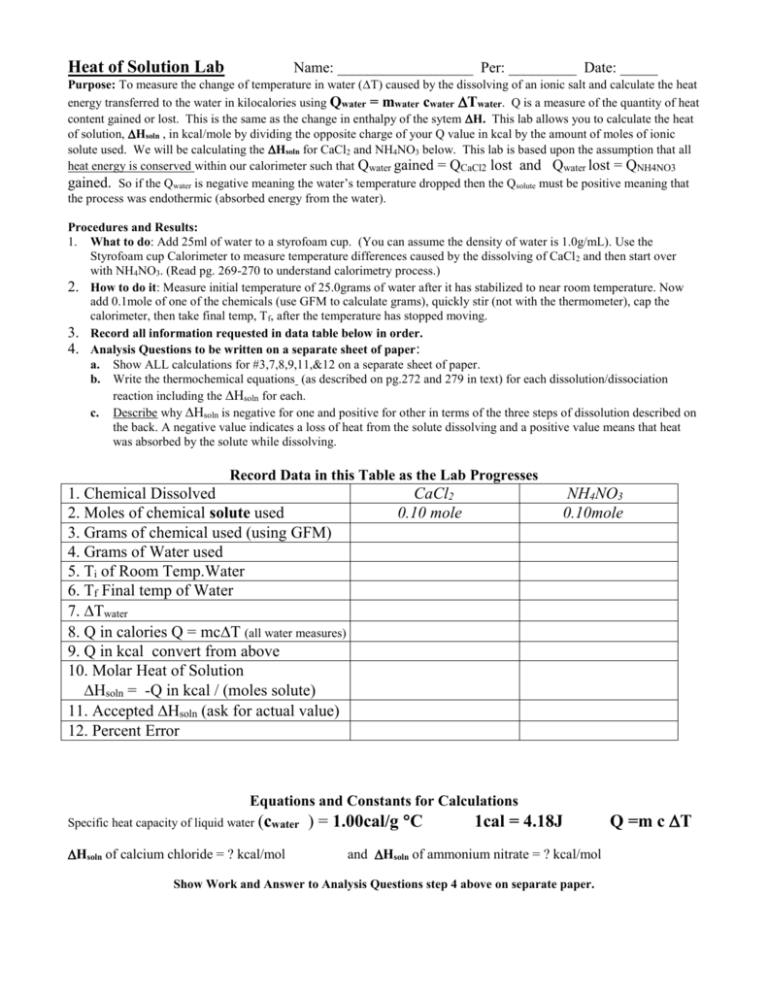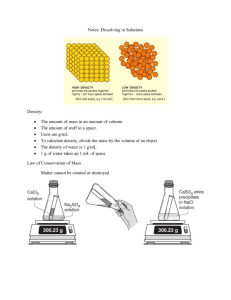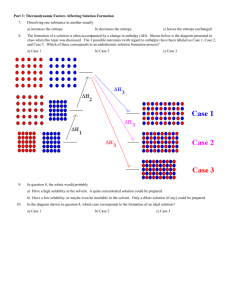Heat of Solution Lab: Calorimetry & Enthalpy Change
advertisement

Heat of Solution Lab Name: __________________ Per: _________ Date: _____ Purpose: To measure the change of temperature in water (T) caused by the dissolving of an ionic salt and calculate the heat energy transferred to the water in kilocalories using Qwater = mwater cwater Twater. Q is a measure of the quantity of heat content gained or lost. This is the same as the change in enthalpy of the sytem H. This lab allows you to calculate the heat of solution, Hsoln , in kcal/mole by dividing the opposite charge of your Q value in kcal by the amount of moles of ionic solute used. We will be calculating the Hsoln for CaCl2 and NH4NO3 below. This lab is based upon the assumption that all heat energy is conserved within our calorimeter such that Qwater gained = QCaCl2 lost and Qwater lost = QNH4NO3 gained. So if the Qwater is negative meaning the water’s temperature dropped then the Qsolute must be positive meaning that the process was endothermic (absorbed energy from the water). Procedures and Results: 1. What to do: Add 25ml of water to a styrofoam cup. (You can assume the density of water is 1.0g/mL). Use the Styrofoam cup Calorimeter to measure temperature differences caused by the dissolving of CaCl 2 and then start over with NH4NO3. (Read pg. 269-270 to understand calorimetry process.) 2. How to do it: Measure initial temperature of 25.0grams of water after it has stabilized to near room temperature. Now add 0.1mole of one of the chemicals (use GFM to calculate grams), quickly stir (not with the thermometer), cap the calorimeter, then take final temp, T f, after the temperature has stopped moving. 3. Record all information requested in data table below in order. 4. Analysis Questions to be written on a separate sheet of paper: a. Show ALL calculations for #3,7,8,9,11,&12 on a separate sheet of paper. b. Write the thermochemical equations (as described on pg.272 and 279 in text) for each dissolution/dissociation reaction including the Hsoln for each. c. Describe why Hsoln is negative for one and positive for other in terms of the three steps of dissolution described on the back. A negative value indicates a loss of heat from the solute dissolving and a positive value means that heat was absorbed by the solute while dissolving. Record Data in this Table as the Lab Progresses 1. Chemical Dissolved 2. Moles of chemical solute used 3. Grams of chemical used (using GFM) 4. Grams of Water used 5. Ti of Room Temp.Water 6. Tf Final temp of Water 7. Twater 8. Q in calories Q = mcT (all water measures) 9. Q in kcal convert from above 10. Molar Heat of Solution Hsoln = -Q in kcal / (moles solute) 11. Accepted Hsoln (ask for actual value) 12. Percent Error CaCl2 0.10 mole NH4NO3 0.10mole Equations and Constants for Calculations Specific heat capacity of liquid water (cwater Hsoln of calcium chloride = ? kcal/mol ) = 1.00cal/g C 1cal = 4.18J and Hsoln of ammonium nitrate = ? kcal/mol Show Work and Answer to Analysis Questions step 4 above on separate paper. Q =m c T Heat of Solution Lab Background and Terms Enthalpy (H) is the total energy of a system. The change in enthalpy (heat energy) of a process is symbolized by H. An exothermic process is one that release excess energy to the environment. An endothermic process is one that absorbs energy from the environment in order to happen. The lattice energy of an ionic solid is a measure of the strength of bonds (cation to anion attraction) in that ionic compound. Thus, it requires energy (endothermic process) to break apart those bonds. Solvation describes the process of polar water molecules being attracted to (and often surrounding) cations and anions of an ionic salt that is being dissolved (this releases free energy). Dissolution (or dissolving) can be viewed as occurring in three steps. If sum of all these energies determines the overall energy properties of the process: 1. 2. 3. Breaking solute-solute attractions (endothermic), which is known as lattice energy in salts (ionic compounds). Breaking solvent-solvent attractions (endothermic), for instance that of hydrogen bonding in water. Forming solvent-solute attractions (exothermic), in solvation. CASE I Dissolving process is Exothermic Process: If the heat given off in the dissolving process (solvation energy) is greater than the heat required to break apart the ionic solid (lattice energy) and separate the water molecules (H bonding energy) the net dissolving reaction is exothermic (energy given off). Thus the solution gets hotter. The addition of added external heat (increases temperature) would only inhibit the dissolving reaction since excess heat is already being produced by the reaction. This situation is not very common where an increase in temperature produces a decrease in solubility. CASE II Dissolving process is Endothermic Process: If the heat given off in the dissolving reaction (solvation energy) is less than the heat required to break apart the solid (lattice enrgy) and separate the water molecules (H bonding energy), the net dissolving reaction is endothermic (energy required). When the dissolving reaction is endothermic – it requires heat. Therefore the heat is drawn from the surroundings, the solution feels cold. The addition of more heat facilitates the dissolving reaction by providing energy to break bonds in the solid. This is the most common situation where an increase in temperature produces an increase in solubility for solids. The use of first-aid instant cold packs is an application of this solubility principle. These basic steps should be followed in the lab to determine the molar heat of solution of any ionic compound: 1. Dissolve a known mass (and mole amount) of ionic compound (the solute) in a known mass (g) of water in a calorimeter. 2. Observe the temperature of the system before and after the dissolution reaction occurs (Celsius or Kelvin). 3. Calculate the change in temperature for the system. (T = Tfinal – Tinitial) 4. Use the temp. change and specific heat of water to calculate the heat content change (Q or H) of water. Q = H = m c T 5. This value for Q will is the oppositve value for Hsol’n because heat absorbed by water is the same as heat lost by solute dissolving 6. Divide the heat of solution by the moles of your ionic solute to obtain the molar heat of solution in kJ/mol or kcal/mol. Hsol’n = -Q water/ (moles of solute) An example similar to your lab: Write the equation for the dissolution of copper(II) bromide. If 29.5 g copper(II) bromide is dissolved in 100.0 mL of water, the temperature changes from 22.10°C to 23.41°C. What is the heat of solution for copper(II) bromide? Assume the specific heat of water, 1.00cal/g•°C. Remember that the heat energy is absorbed by the entire solution that includes the solvent as well as the solute. Recall that the density of water is 1.00 g/mL, so 100.0 mL of water is also 100.0 g water. Solution: Copper(II) bromide is made of a Cu2+ ion and Br– ion, so the reaction is CuBr2 Q = (mass)(specific heat)( T) Q = (100g)(1.00 cal/g•°C)(23.41 °C – 22.10 °C) Cu2+ + 2 Br– Q = (100g)(1.00)(1.31) Q = 131.0cal gained by water and thus H = 131.0cal lost by the solute CuBr2 Hsol’n = Q in cal / (moles of solute) = 131.0cal / 0.13mole =1008cal/mol OR Hsol’n = 1.008kcal/mol lost by the solute since we had 29.5g CuBr2 divided by the GFM of 222.0g/mole to determine that we used 0.13moles. We could also say that Hsol’n = -1.008cal/mol with the negative value indicating the a loss of heat from the solute.






